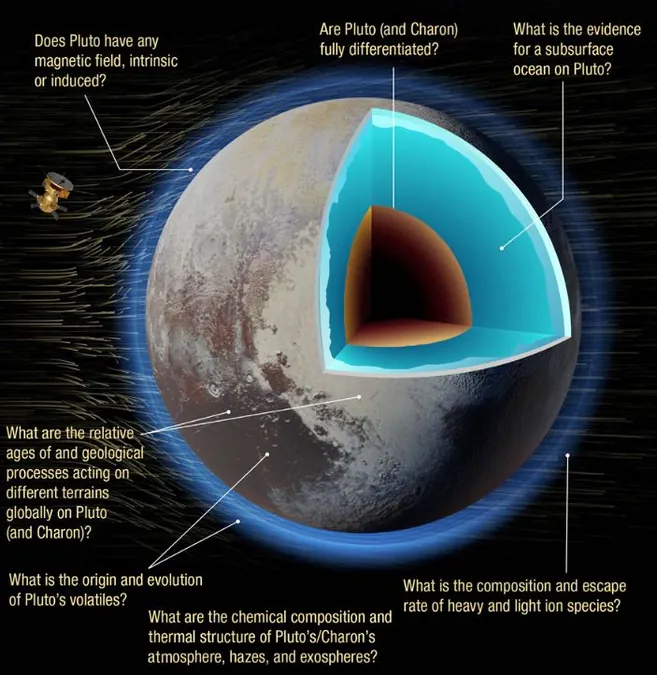
Journey to the Edge of the Solar System: The Persephone Mission to Pluto Could Unlock Its Deepest Secrets!
2024-11-14
Author: Rajesh
Introduction
Pluto, once celebrated as the ninth planet of our solar system, may have lost its title, but it continues to captivate astronomers and planetary scientists around the globe. Now, a passionate and dedicated team from numerous academic institutions is pushing for an ambitious new mission, dubbed "Persephone," aimed at exploring the mysterious realm of Pluto and its largest moon, Charon. This mission not only promises to uncover the secrets of these distant worlds but could also take as long as 50 years to complete!
The New Horizons Legacy
The New Horizons spacecraft, which made history by zooming past Pluto in 2015, was the first to provide valuable insights into this dwarf planet and its celestial companion, Charon. While New Horizons gathered a wealth of information, scientists have expressed a strong desire for more detailed data, especially about Pluto's intriguing surface features. The Persephone mission is designed specifically to address these unanswered questions.
Scientific Inquiries of the Persephone Mission
According to a paper unveiled in 2021, Persephone aims to tackle four pivotal scientific inquiries: 1. **Evolution of the Kuiper Belt:** How has the population of this vast region of icy bodies changed over time? 2. **Environmental Conditions:** What are the particle and magnetic field environments that exist within the Kuiper Belt? 3. **Surface Changes:** How have the surfaces of Pluto and Charon transformed since the New Horizons flyby? 4. **Internal Structures:** What secrets lie within Pluto and Charon, and does Pluto harbor a hidden subsurface ocean?
The Fascination of a Hidden Ocean
The potential existence of a subsurface ocean beneath Pluto's icy crust is particularly fascinating. Preliminary evidence, including the discovery of the enigmatic Sputnik Planitia ice sheet, suggests that geological processes may be at work, possibly indicating an ocean beneath the surface. The Persephone mission could provide the essential data needed to confirm or dispel these tantalizing theories.
Challenges and Timeline
However, there are challenges ahead. Due to the intricacies of orbital mechanics and the limitations of current propulsion technology, the journey to Pluto would be lengthy, requiring several decades to complete—even with a gravity assist swing-by from Jupiter. The preliminary mission design of Persephone has been in the works for nearly 31 years, which comprises a 28-year cruise phase followed by a three-year orbital period around Pluto and Charon. After finishing its primary mission, the spacecraft could continue to explore additional Kuiper Belt objects, broadening our understanding of this remote region.
Innovations in Propulsion Technology
Exciting innovations in nuclear electric propulsion technology may help accelerate the mission timeline, possibly reducing travel time by up to two years. However, it's unclear if such advancements will be available by the proposed 2031 launch date aboard an SLS rocket.
Scientific Instruments on Board
Regardless of propulsion advancements, Persephone is equipped with an extensive array of scientific instruments, including cameras, spectrometers, radar, magnetometers, and altimeters. This suite of sensors will provide critical data on every object the spacecraft encounters, including the fascinating worlds of Jupiter and its many moons.
Extended Orbital Duration
Distinct from a fleeting flyby, Persephone is designed to be an orbiter, allowing it to linger around Pluto and Charon for three years. This extended duration is critical for capturing detailed data on their dynamic surfaces and complex geophysical processes.
Budget and Funding
As funding proposals for outer-planet exploration intensify, Persephone stands out with an estimated budget of $3 billion. While this amount places it in the upper tier of mission costs, the potential returns in knowledge and insights about Pluto and the broader Kuiper Belt may well justify the investment.
Conclusion
The scientific community eagerly anticipates a future where Persephone can reveal the many secrets that Pluto holds, years after New Horizons has paved the way for deeper exploration of our solar system's most enigmatic inhabitants. Stay tuned, as the adventure to the edge of our solar system is just beginning!



 Brasil (PT)
Brasil (PT)
 Canada (EN)
Canada (EN)
 Chile (ES)
Chile (ES)
 Česko (CS)
Česko (CS)
 대한민국 (KO)
대한민국 (KO)
 España (ES)
España (ES)
 France (FR)
France (FR)
 Hong Kong (EN)
Hong Kong (EN)
 Italia (IT)
Italia (IT)
 日本 (JA)
日本 (JA)
 Magyarország (HU)
Magyarország (HU)
 Norge (NO)
Norge (NO)
 Polska (PL)
Polska (PL)
 Schweiz (DE)
Schweiz (DE)
 Singapore (EN)
Singapore (EN)
 Sverige (SV)
Sverige (SV)
 Suomi (FI)
Suomi (FI)
 Türkiye (TR)
Türkiye (TR)
 الإمارات العربية المتحدة (AR)
الإمارات العربية المتحدة (AR)